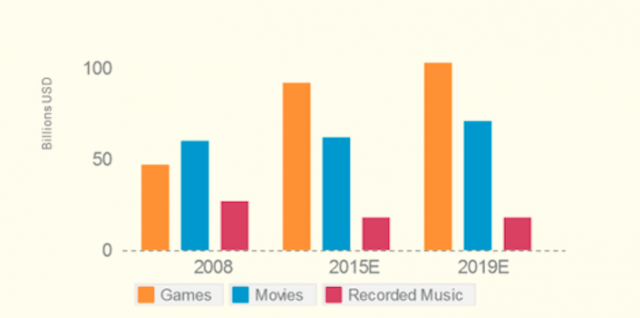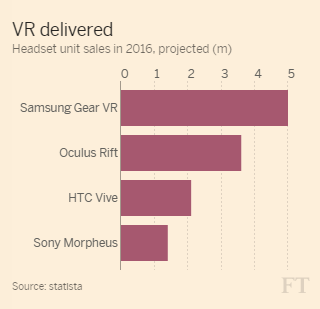Among the hottest topics at this year’s CES was virtual and augmented reality (VR and AR for short.) The technology has received much ink of late, especially for an aging technology that dates back at least to 1991 with a Sega VR headset and perhaps much earlier, when you consider pioneers like James Lanier of VPL Research in 1980. But the most recent momentum from Facebook’s first push into the space and its acquisition of Oculus VR for an eye popping $2B (when its all said and done) back in August 2014, brought that aging phoenix from the ashes of past market failures and once again into the limelight. Here’s why CES made such a fuss, and perhaps why this time, the stars just may be aligned to see this technology clear into the consumer mainstream.
First, multiple headline grabbing announcements for VR were made at the show regarding shipping and pricing for the long awaited Oculus Rift consumer device. Prices start at $599, much higher than demo units first sold to developers in 2015. This move, plus consumer versions of HTC’s Vive, a new Sony iteration now residing in the PS4 group under the moniker Sony Playstation VR (formerly project Morpheus) and perhaps a score of lesser known devices all now conspire to drive adoption of VR headsets as high as 12M units world wide, by the end of this year according to Statista (see chart below).
In contrast, Dan Cryan an IHS analyst and Sr. Director Media Content, that said 7M units will ship in 2016, but Cryan also said he expects by 2020 the headset market will reach $2.6B and roughly 37M headsets, as published in the recent CES Media Crib Sheet, 2016. Worldwide Direct Consumer Spending on Entertainment, All Forms ($bn) Source: IHS June 2015
Worldwide Direct Consumer Spending on Entertainment, All Forms ($bn) Source: IHS June 2015
It’s the Game market that will drive these sales, at least at first, and Cryan also provides some insight here as well. He noted back in June 2015 at the E3 Conference, that “Games spend is more than movies and recorded music combined.” And it takes little convincing to anyone who has tried on these latest generation VR goggles that the experience is visceral, moving, and yes, even perhaps game changing.
By the numbers according to IHS at the June E3 entertainment conference, in 2015 games reached $92B world wide compared to film’s $62B and recorded music’s $18B in 2015.
- Worldwide game spending has increased by $44B since 2008
- $92B or 21% of total entertainment spending globally was on games in 2015
- $100B in games spending is forecast by IHS by 2017
But looking beyond games (and CES) there’s an evolving media form of games, entertainment and VR that recently came to light. A January 8th announcement, covered in the Financial Times (FT), said that blockbuster film “The Martian” is heading for a VR experience of sorts. Moviegoers can buy a VR experience and try on the Matt Damon space suit courtesy of Fox innovation lab, according to FT reports.
Fox Home Entertainment head Mike Dunn characterized the appeal of this “…the new platform …could be a new form of media, a marketing endeavor that we can sell, [so] consumers will have to want to use it again and again.” And here IHS’ Cryan agrees. He was quoted in the FT story as saying “What Hollywood brings to this is massive expertise in traditional storytelling and a huge library of intellectual property, VR is a new medium that brings together Hollywood and video games in a way that we haven’t seen before”.
 Statista VR Devices unit sales recently published in tht FT, Source StatistaCurrently there are four kids on the block in VR with many more white box and China-based vendors waiting in the wings. The Financial Times also included data from marketing firm Statista that reckons the Samsung Gear, which has a relatively low price, will dominate the VR space in 2016. That device uses a Samsung Smartphone to both provide its VR display (with an Android app that splits the screen) and processor to power the VR software. Sales for the Gear VR should hit 5M in 2016. The famous Oculus Rift should hit second place in VR sales in 2016 with just under 4M units, and HTC Vive and Sony will reach up to 2.0M and 1.5M units respectively. Granted these numbers are a bit more bullish than the IHS high end of 7M but the wave of interest is growing, and with the Rift due to ship soon, we won’t have long to wait to see if things really do pan out this way.
Statista VR Devices unit sales recently published in tht FT, Source StatistaCurrently there are four kids on the block in VR with many more white box and China-based vendors waiting in the wings. The Financial Times also included data from marketing firm Statista that reckons the Samsung Gear, which has a relatively low price, will dominate the VR space in 2016. That device uses a Samsung Smartphone to both provide its VR display (with an Android app that splits the screen) and processor to power the VR software. Sales for the Gear VR should hit 5M in 2016. The famous Oculus Rift should hit second place in VR sales in 2016 with just under 4M units, and HTC Vive and Sony will reach up to 2.0M and 1.5M units respectively. Granted these numbers are a bit more bullish than the IHS high end of 7M but the wave of interest is growing, and with the Rift due to ship soon, we won’t have long to wait to see if things really do pan out this way.
At the show, we saw the fruits of what recent VR (and AR) technology research has brought. We were given a peek at SIGGraph this past summer at prototypes from corporate and university research labs that demonstrated cutting-edge engineering feats and new technology milestones and we have previously reported on those in these pages.
At SIGGraph, NYU’s Hologram included a fully immersive VR interaction (yes more than one VR player at a time) that included real-time tracking using the processing power of a Samsung smartphone and made headlines. Also, USC’s Interactive Labs was on hand with its infinite space “mind hack” that tricked VR voyagers into thinking they were walking in an endless space. That was quite a nice trick for those looking for the VR2 experience of total freedom of movement (in a confined space) that will be necessary to help users suspend reality and absorb the “virtual”.

